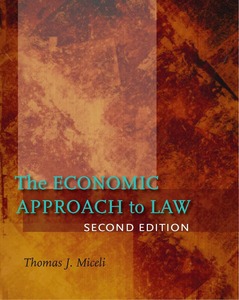Chapter 8
The Economics of Dispute Resolution
Key Points
• Economists are concerned with the process of dispute resolution because litigation is costly, and economic theory may suggest ways to lower this cost. Also, the litigation process determines how the common law evolves because only those disputes that come before the courts can affect legal change.
• Plaintiffs and defendants have a common interest in resolving their disputes out of court so as to avoid the costs of trial. Consistent with this prediction, the vast majority of disputes settle out of court. The key question then becomes: why do any cases go to trial?
• The differing perceptions, or optimism, model of dispute resolution says that trials occur when plaintiffs and defendants are mutually optimistic about the outcome of a trial. This model predicts that trials become more likely as the costs of a trial decrease and as the stakes of a trial increase.
• The asymmetric information model of trials says that trials can result when one party to the dispute holds private information about his or her prospects at trial. This model yields the same basic predictions regarding when a trial is more likely to occur.
• The social value of a lawsuit is its ability to induce potential injurers to take cost-effective care, while the private value is the gain the plaintiff expects at trial less the filing cost. Generally, these two valued will not coincide. As a result, there may be too many or too few suits from a social perspective.
• The process of pretrial discovery can promote settlement by reducing disagreement and/or asymmetric information prior to trial.
• The English, or loser-pays, rule requires the loser at trial to pay the winner’s litigation costs. Switching to this rule has an ambiguous effect on settlement: whereas it reduces the likelihood of settlement by raising the stakes at trial, it increases the likelihood of settlement by increasing the riskiness of trial.
• The English rule discourages the filing of low quality suits, and encourages the filing of high quality suits. Empirical and experimental evidence generally supports the theoretical predictions regarding the impact of the English rule.
• Rule 68 shifts the defendant’s trial costs to the plaintiff if the plaintiff rejects a settlement offer and then receives a lower judgment at trial. Theory predicts that this rule should promote settlement by expanding the settlement range.
• The most common form of compensation for plaintiffs’ lawyers in tort suits is a contingent fee, under which the plaintiff pays the lawyer a fixed percentage of his or her recovery.
• Contingent fees provide lawyers an incentive to work hard for the client by giving them a stake in the outcome of the case. However, they may distort the settlement-trial decision by encouraging too many settlements and may promote frivolous suits.
• Frivolous suits, or suits lacking legal merit, may nevertheless succeed in eliciting a settlement if defendants are uncertain about the probability of plaintiff victory at trial (as in the asymmetric information model), and if the fraction of frivolous claims is small.
• Court delay is an important problem in the dispute resolution process. Defendants may be able to use delay strategically to lower their costs by sorting plaintiffs according to their time discount rates.
• An important conjecture in the economic analysis of law is that the common evolves toward efficiency. The question of which disputes go to trial is important in evaluating this claim because only those disputes that make it to trial can affect the direction of legal change.
• Two conditions are sufficient for the law to evolve toward efficiency: first, inefficient laws are more likely to be litigated than efficient laws, and second, judges are not biased against efficiency.
• Judges often decide cases by following precedent; that is, by invoking a ruling from a past, similar case. This is an efficient way to make decisions under uncertainty if decision costs and the likelihood of judicial error are high. However, it may impede the evolution of the law by entrenching inefficient rules.
• The standard of proof in a legal proceeding is optimally chosen to minimize the expected cost of legal error. Specifically, the optimal standard of proof balances the costs of false acquittals (type 1 errors) and false convictions (type 2 errors). The higher standard of proof in criminal trials as compared to civil trials reflects the higher cost of false convictions in criminal cases.
• Judges may affect the direction of legal change by seeking to impart their own biases onto the law. Precedent and selective litigation (the fact that inefficient laws disproportionately go to trial) mitigate the potentially detrimental effects of judicial bias on efficiency.
